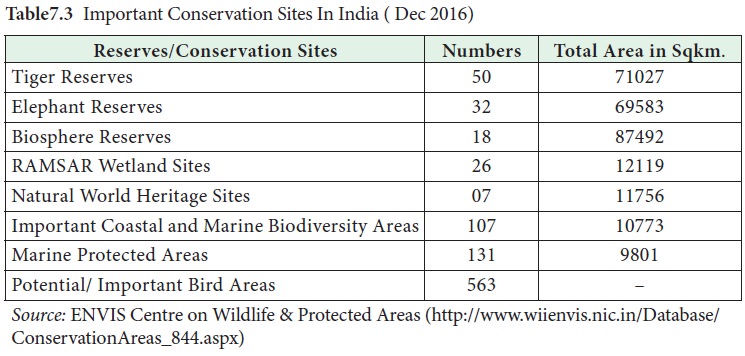Introduction
The earth was formed 4.6 billion years ago. Geographers are concerned about the earth and its various spheres. These spheres did not exist on the primitive earth as they are today. They evolved over a long period of time after the earth was formed. There was no life on earth for a very long time. Scientists believe that the first life forms on earth came into existence about 3.5 billion years ago. Which marked, ‘The birth of the biosphere’.
Since then life has multiplied in numbers and varieties and evolved to the
In the last 100 years, man has had used, overused and misused the natural resources of the earth. This has disturbed the ecological balance of the earth. The realization about the damage caused to earth by our action came when we began to experience global warming, desertification, increase in disease and distress and recurrence of severe natural disasters.
It was in 1962 that Rachel Carson published the book ‘Silent Spring’ which inspired an environmental movement that led International agencies to focus their attention on protecting and sustaining the biosphere.
In 1971, UNESCO launched the Man and the Biosphere Programme to study our impact on nature and how it could be minimized. Even after several decades the programme still continues to shape the future of sustainability of the earth.
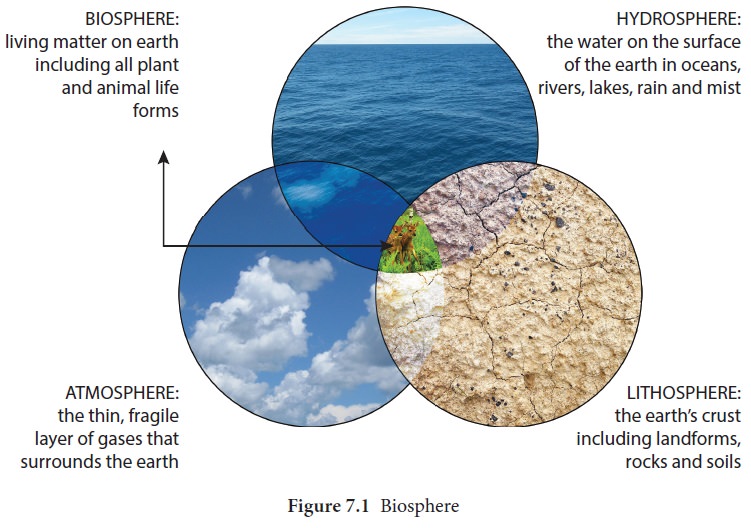
Biosphere
The word Biosphere originates from the Greek words bios = life and sphaira = sphere. Earth is the only planet in the solar system that supports life. There are many reasons that contribute to this and the most important being the earth’s distance from the sun, the presence of oxygen in the atmosphere and the presence of water.
The above factors, along with the existence and interaction of the three spheres of the earth (the lithosphere, hydrosphere and atmosphere) gives rise to the fourth sphere which is the life sphere or biosphere (Figure 7.1). The term Biosphere was coined by Eduard Suess in 1875. Later contributions to the study of biosphere were from, Charles Darwin and many other scientists.
Thus, in the biosphere, life exists on land, water and air and life forms range from microorganisms to plants, animals, birds, amphibians, reptiles and mammals including human beings.
The biosphere is formed of biotic components. It consists of organisms, population, community and ecosystem.
Ecosystem
Organism – includes animals, plants and micro organisms.
Population – is a group of similar plants or animals living in an area.
Community – refers to all the plants and animals living in an area.
Ecosystem – all living and non living things and their interaction within an area.
Life cannot exist in isolation. It flourishes in an environment which supplies and fulfills its material and energy requirements. A biotic community and its physical environment in which matter and energy flow and cycle is called as ecosystem.
The term ecosystem was first proposed by Arthur George Tansley in 1935. Tansley defined ecosystem as, ‘the system resulting from the integration of all living and non-living factors of the environment’. The ecosystems can vary in size. It can be very small, extending to about a few square centimeters or it can extend over many square kilometers. Example; tropical forests.
Major components of an ecosystem
The ecosystem is made up of two main components:
- Abiotic Component and
- Biotic Component
A. Abiotic Component: This component of the ecosystem includes the non-living substance of the environment. Example; light, air, soil, water, climate, minerals, etc. Sun is the main source of energy for the earth.
B. Biotic Component: This includes a variety of living organisms such as microorganisms, plants and animals. The biotic component of an ecosystem can be further divided into producers, consumers and decomposers based on their capacity to sustain themselves (Figure 7.2).
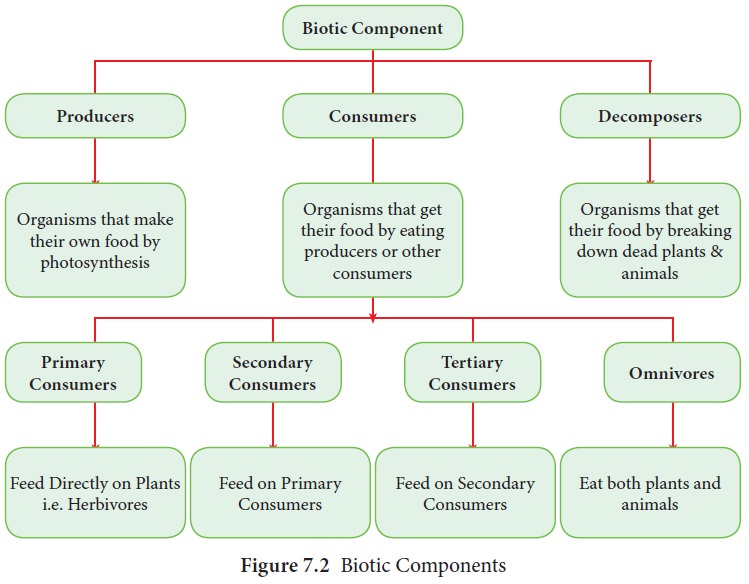
a. Producers: Organisms that can produce or manufacture their own food are known as producers. Plants that have green pigments or chlorophyll, produce their own food in the presence of CO2 in the atmosphere, water from the soil and sunlight through a process called ‘photosynthesis’. These green plants are called as ‘autotrophs’ (auto – self; trophs – nourishing) as they manufacture their own food.
b. Consumers: Consumers are organisms that cannot manufacture their own food and get their food and nutrients from producers directly or from other organisms. They are called as ‘heterotrophs’ (hetero – others; trophs – nourshing).
Consumers can be divided into primary, secondary and tertiary consumers.
1. Primary Consumers
Organisms that feed on producers (green plants) are called primary consumers. They are also called as ‘herbivores’ or plant eating organisms. Examples of terrestrial herbivore are grasshopper,sheep, goats, cow, rabbit, deer, elephant etc. Examples of aquatic herbivores are zoo plankton, krill, squid, small fish, sea urchin, etc.
2. Secondary Consumers
Animals that kill and eat the herbivores or plant eating animals are called secondary consumers. They are also called as ‘carnivores’, Example; lion, tiger, foxes, frogs, snakes, spider, crocodiles, etc.
3. Tertiary Consumers
They are top predators in a food chain. They are carnivores at the topmost level in a food chain that feed on other carnivores or secondary consumers. Example: an owl eats a snake but an owl is eaten by a hawk, therefore a hawk is a tertiary consumer. Tertiary consumers that occupy the top trophic level, and are not predated by any other animals are called ‘apex predators’. However, when they die their bodies will be consumed by scavengers besides the decomposers Example; alligator andhawk.
Some organisms eat both plants and animals. These animals are called as‘omnivores. Example; cockroach, foxes, seagull and human.
Some omnivores are ‘scavengers’, which eat food that other animals have left behind Example; hyena and vultures.
Plants and animals that live on or inside other plants or animals are called as Parasites. Example; mistletoe lives on other plants. Other examples are tapeworms, round worms, lice, ticks, flea etc.
‘Detritivores’ are consumers that feed on detritus. Detritus includes fallen leaves, parts of dead trees and faecal wastes of animals. Ants, termites, earthworms, millipedes, dung beetle, fiddler crabs and sea cucumbers are detritivores.
4. Decomposers
Decomposers are organisms that help decompose dead or decaying organisms. Decomposers are also heterotrophs. Decomposers are nature’s built-in recycling system. By breaking down materials – decomposers return nutrients to the soil. They, in turn, create another food source for producers within the ecosystem. Mushrooms, yeast, mould, fungi and bacteria are common decomposers.
Food Chain and Food Web
Every living creature in an ecosystem has a role to play. Without producers, the consumers and decomposers would not survive because they would have no food to eat.
Without consumers, the populations of producers and decomposers would grow out of control. And without decomposers, dead producers and consumers would accumulate as wastes and pollute the environment.
All organisms of an ecosystem depend on one another for their survival. Each organism living in an ecosystem plays an important role in the flow of energy within the system. Organisms need energy for respiration, growth, locomotion, and reproduction. This movement of energy is usually understood through food chains or food webs. While a food chain shows one path along which energy can move through an ecosystem, food webs show all the overlapping ways that organisms live with and depend upon one another.
A. Food Chain
A food chain describes the flow of food in an ecosystem. This flow or feeding structure in an ecosystem is called ‘trophic structure’. Each level in this structure is called a trophic level. A food chain starts the movement of energy from one trophic level to the next (Figure 7.3). Example; Plant (primary producer) is eaten by a rabbit (herbivores, primary consumer), rabbit is eaten by a snake (carnivores, consumer or primary carnivore)and the snake is eaten by a hawk (tertiary consumer).
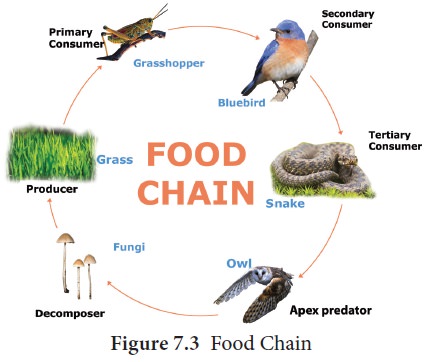
Food Web
A Food Web is a complex network of interconnected food chains. Food chains show a direct transfer of energy between organisms.
A chain might involve a mouse eating some seeds on the forest floor, a snake eating the mouse and later an eagle eating the snake.
With each step, some of the energy from the sun, which is trapped within the seeds, is getting passed on.
In a food web, the mouse might eat seeds, but it also might eat some grains, or maybe even some grass. The mouse might be eaten by a snake, or the eagle, or even a fox. The snake could be eaten by the eagle, but also might be eaten by a fox in the forest.
Since each organism can eat multiple organisms and be eaten by multiple organisms, a food web is a much more realistic scheme of the transfer of energy within an ecosystem (Figure 7.4).
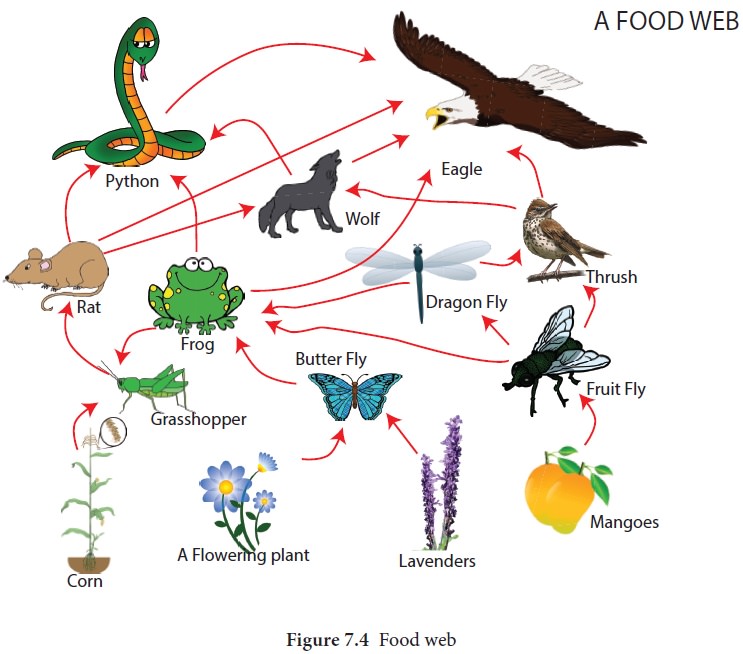
Food chains and food webs are found in both terrestrial and aquatic ecosystems.
Organisms in a food chain or food web are linked and dependent on one another for survival. If organisms in one trophic level become threatened, it impacts the organisms in other trophic levels. Primary consumers get less food due to loss or destruction of habitat.
This in turn means less primary consumers for secondary and tertiary consumers to feed on.
The plant and animal species in such an environment could become endangered or even extinct. For this reason, it is vital that an ecosystem remains balanced containing an appropriate proportion of producers and consumers.
Energy Flow in an Ecosystem
Energy in an ecosystem flows from producers to consumers. The available energy in a food chain decreases with each step or trophic levels up in the food chain. As such, there is less energy available to support organisms at the top of the food chain. That is why the tertiary and quaternary consumers are far less in number in an ecosystem than organisms at lower trophic levels.
Energy Pyramids
Energy pyramids are another tool that ecologists use to understand the role of organisms within an ecosystem. As you can see, most of the energy in an ecosystem is available at the producer level. As you move up on the pyramid, the amount of available energy decreases significantly. It is estimated that only about 10% of the energy available at one trophic level gets transferred to the next level of the energy pyramid. The remaining 90 percent of energy is either utilized by the organisms within that level for respiration and other metabolic activities or lost to the environment as heat.
The energy pyramid shows how ecosystems naturally limit the number of each type of organism it can sustain (Figure 7.5).
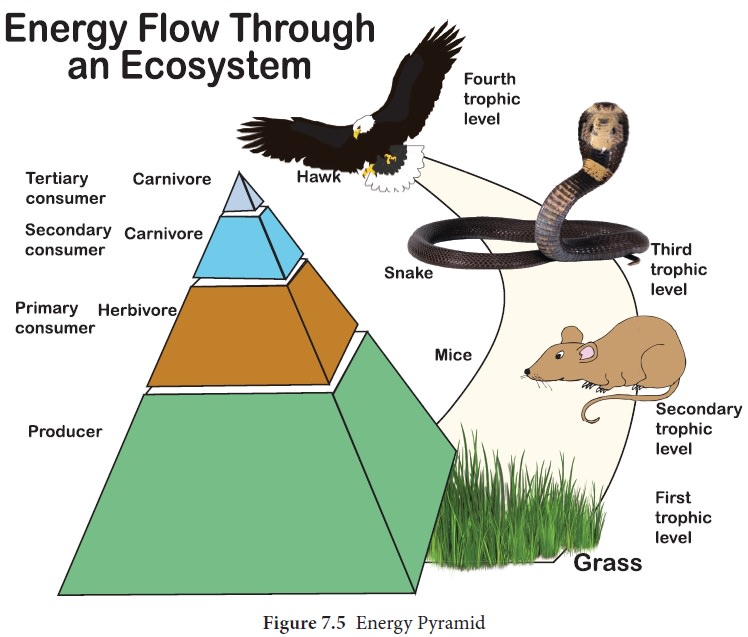
Cycles in an Ecosystem
Nutrients move through the ecosystem in cycles is called ‘biogeochemical cycles’. A biogeochemical cycle is a circuit or pathway by which a chemical element moves through the biotic and the abiotic components of an ecosystem. All life processes are associated with the atmosphere by important cycles such as the Carbon, Oxygen, Nitrogen cycles etc. Through these cycles energy and materials are transferred, stored and released into various ecosystems. Let us discuss one of biogeochemical cycles in detail – the Carbon cycle.
The Carbon Cycle
Carbon is exchanged, or cycled among all the spheres of the earth. All living organisms are built of carbon compounds. It is the fundamental building block of life and an important component of many chemical processes. Living things need carbon to live, grow and reproduce. Carbon is a finite resource that cycles through the earth in many forms.
Carbon is an essential element in all organic compounds and since there is only a limited amount available it must be recycled continuously. This takes place in the biosphere. Atmospheric carbon is fixed in green plants through photosynthesis.
This carbon is passed on to other living organisms through the food chain. The carbon food compound is utilized and later released to the atmosphere through the process of respiration.
By-products of respiration are carbon-dioxide and water which are returned to the air.
A carbon cycle is completed by decomposers like bacteria and fungi which break down dead plants and animal tissues there by releasing some carbon to the air, water and soil.
All producers and consumers are not decomposed. The organic matter of some of them is preserved in fossil fuels such as coal and petroleum for millions of years.
In a carbon cycle (Figure 7.6), carbon moves between reservoirs. Carbon reservoirs include the atmosphere, the oceans, vegetation, rocks, and soil.
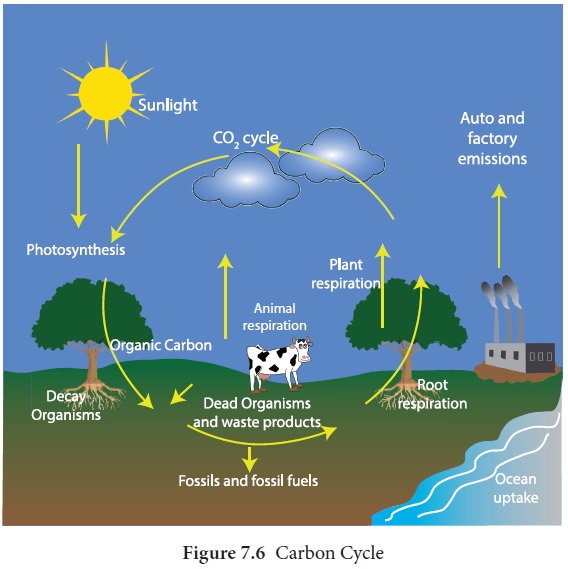
Today, the carbon cycle is changing. Human activities have added more carbon into the atmosphere. More carbon is moving to the atmosphere when fossil fuels, like coal and oil, are burned. More carbon is moving to the atmosphere as humans destroy the forest. This increase in carbon in the atmosphere causes the earth to warm up more than the normal level, leading to climate change and many problems connected with it.
Biomes
An ecosystem as already explained consists of a biological community and an abiotic environment. Ecosystem may be broadly divided into land or terrestrial ecosystem and water or aquatic ecosystem. The aquatic ecosystem can be further divided into freshwater and marine ecosystem.
An ecosystem becomes a biome when it extends over a large area. According to I.G. Simmons (1982) the most extensive ecosystem unit which is convenient to designate is called a ‘Biome’.
It may be concluded that a biome is in fact a large ecosystem where we study the total assemblage of plant and animal communities. Since vegetation is the most dominant component of a biome and as vegetation and climate are very intimately related, the world is divided into a number of biomes based on major world climatic types (Figure 7.7).
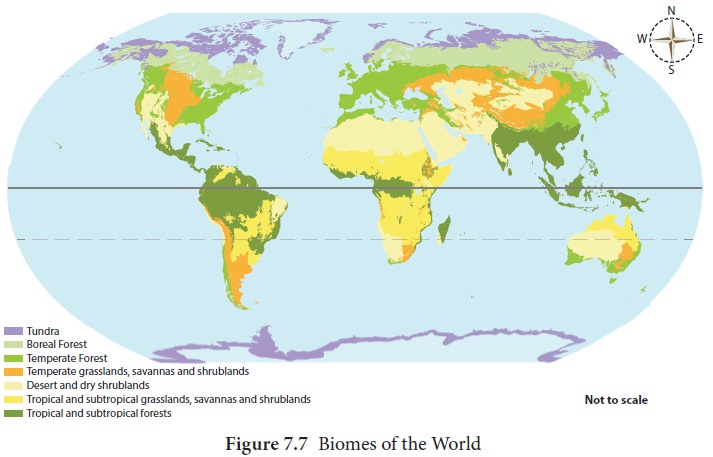
Types of Biomes
World Biomes are mega ecosystems existing and operating over large areas. These divisions are based on climate pattern, soil types, and the animals and plants that inhabit an area. Basically, biomes are classified into two major groups such as Aquatic biomes andTerrestrial biomes.
Wetlands are transition zones between aquatic and terrestrial biomes
To understand the earth biomes, it is necessary to understand the following:
- The characteristics of regional climates.
- Aspects of the physical environment.
- The type of soil and the processes contributing to soil development.
- The distribution of flora in the area.
- The distribution of fauna in the area and their adaptation to the environment.
I. Aquatic Biomes
The aquatic biomes are the most important of all the biomes as, the water forms the vital resource and is essential for any life form. Since many types of species live in the water, it is one of the most important natural resources that need to be protected.
Aquatic Biome is further divided into:
A. Fresh Water Biome and
B. Marine Biome
A. Fresh Water Biome
These biomes are spread over all parts of the earth and have different set of species depending on their location and climate. Fresh water biomes include areas of ponds, lakes, streams, rivers and wetlands. Lakes and ponds are stagnant water bodies and are smaller in their area. The diversity of life forms in river changes with increasing water volume. For example, Dolphins are found in the river Ganges, Brahmaputra and the Indus which carry huge volumes of water.
B. Marine Biome
Marine biome is an aquatic biome which is salt water biome occupying seas and oceans of the world. Marine biome plants have various roles, plants such as sea grasses and macro algae give shelter and nutrient for many animals.
Marine plants are sources of nutrients for the corals and help corals to build up reefs. The reefs are kept intact by plants like coralline algae.
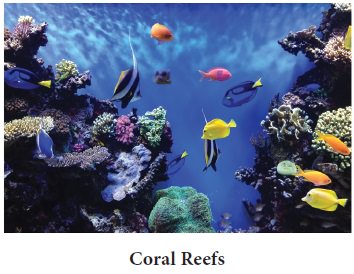
Corals are marine invertebrates which live in compact colonies. They inhabit tropical oceans and seas. Corals cannot survive in waters below 20°C but grow optimally in temperatures between 23°–29° Celsius. Coral reefs are marine ecosystems which are held together by structures made of calcium carbonate secreted by the corals. Coral reefs are mainly classified into three types – Fringing reef, Barrier reef and Atoll .
Fact File
Sea grasses are plants that live in saltwater. There are over 50 species of sea grasses. Sea grasses have flowers, roots, and specialized cells to transport nutrients within a plant. This makes them similar to land plants and different from algae or seaweeds.
Fringing reefs grow seaward from the shore along the coast forming a fringe. They are the common type of reefs.
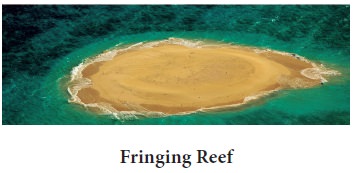
Barrier reefs also border the shoreline but are separated from the coast by an expanse of water or lagoon.
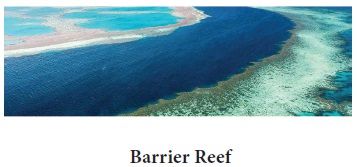
Atolls are coral reefs that are circular in shape enclosing a lagoon with absence of an island in the center.
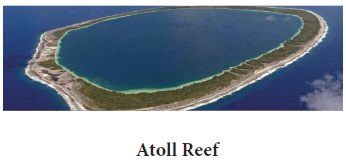
Marine biome includes fishes, whales, crustaceans, molluscs, sea anemones, fungi and bacteria. Marine species are continuously impacted by change in climatic condition and the oceans are frequently disturbed by ocean waves and currents.
C. Wetlands
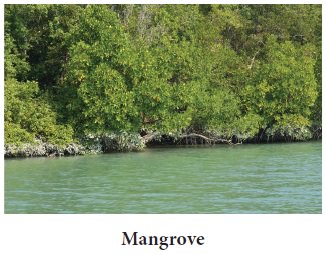
A wetland is an area of land which is permanently or periodically saturated with water and exists as a distinct ecosystem. Wetlands play many roles in the environment, such as water purification, flood control, carbon sink and shoreline stability. Wetlands are home to a wide range of aquatic plants and animal life. Wetlands can be freshwater, brackish, or saltwater. Examples of aquatic vegetation that thrive in wetlands are milkweed, bald cypress trees, mangroves and cattails.
Fact File
Crustaceans are chiefly aquatic arthropods having a body covered with a hard shell or crust and several pairs of legs. Example: crab, lobsters, crayfish, barnacles shrimps, krill etc.
Molluscs are organisms with soft bodies. Often their bodies are covered by hard shells. Example: snail, slug, squid, cuttlefish, mussel, clams, oysters, octopuses etc.
Fact File
A Bog is a type of wetland ecosystem characterized by wet, spongy, poor-ly drained peaty soil formed from dead plants specially moss. Bogs have moss, sedges, grasses, such as cotton grass; insectivorous plants like pitcher plants; and many orchids. The gradu-al accumulation of decayed plant ma-terial in a bog functions as a carbon sink.
A Fen is a low land that is covered wholly or partly with water. They re-ceive nutrients from ground water and have peaty alkaline soil. Their charac-teristic flora are sedges and reeds.
Mangrove swamps are coastal wetlands found in tropical and subtropical regions. These wetlands are often found in estuaries, where fresh water meets salt water. Mangrove trees dominate this wetland ecosystem due to their ability to survive in both salt and fresh water. The Sundarbans is the largest Mangrove region in the world and a UNESCO World Heritage Site.
Mangrove forests of Tamil Nadu
Mangrove forests are found along the coast of Tamil Nadu in Pichavaram, Muthupet, Ramnad, Gulf of Mannar and Punnakayal.
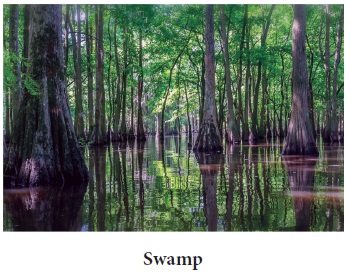
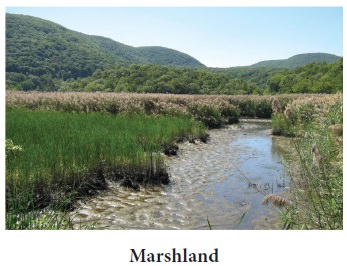
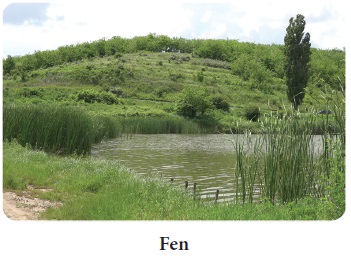
II. Terrestrial Biome
Terrestrial biomes are very large ecosystems over land and they vary according to latitude and climate. They can be divided into numerous sub-types. In this lesson they are broadly divided into eight types.
i. Tropical Evergreen Rain Forest Biome
Tropical Evergreen Rain Forest Biome extends between 10° North and South of the equator (Figure 7.8). This biome is seen in the Amazon Basin of South America, Congo Basin of Africa and the Indo Malaysian Region of Southeast Asia (Java, Sumatra, Borneo, Malaysia and Guinea)
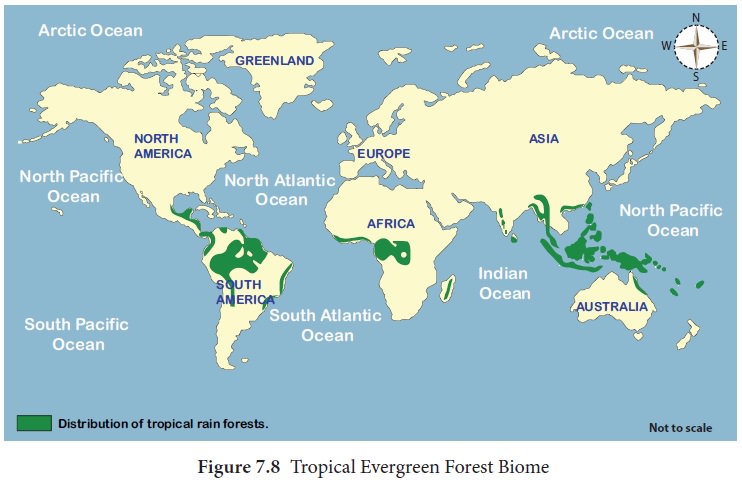
This biome receives direct sunlight throughout the year and so temperatures are high year round. The average annual temperature is 20°C to 30°C. The average annual rainfall of the tropical evergreen rain forest is 200cm.
The Tropical Evergreen Rain Forest Biome has the largest number of plant and animal species. Broad leaved, tall evergreen hard wood trees are found in this biome. Trees grow up to 20 to 35 meters high. The forest is characterized by thick undergrowth and creepers. The main trees in this biome are mahogany, rose wood, ebony, cinchona, rubber, coconut palm, cane, bamboo etc.
This forest biome has innumerable insects, birds, reptiles and furless animals. At the edge of the forest animals like gorilla, and monkey are found.
Important tribes inhabit this biome, for example the Pygmies in the jungles of Africa and the Yanomani and Tikuna tribes of the Amazon region. Traditionally they live by hunting and gathering food. In the recent years in South East Asia, the tropical evergreen rainforest has been slowly replaced by rubber and sugarcane plantations. The human settlements in this biome are small and scattered.
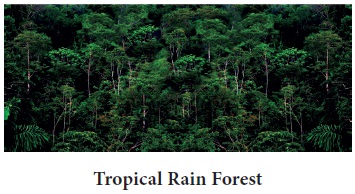
ii. Tropical deciduous Forest/Monsoon Forest
Tropical deciduous forest is found in the regions experiencing monsoon climate. This biome is also called as the dry forest or monsoon forest biome.
This is found in South and South East Asia in parts of India, Myanmar, Vietnam, Thailand, Cambodia and southern coastal China. It is also found in eastern Brazil and in smaller areas in South and Central America, the West Indies, southeastern Africa, and northern Australia.
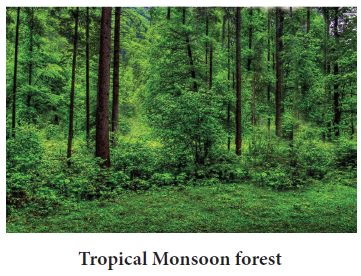
In this biome, the temperature varies from one season to another season. In summer the maximum temperature ranges from 38°C to 48°C. Summer season is warm and humid. In the dry winter season temperature ranges between 10°C to 27°C. The total amount of precipitation is 75 to 150 cm/year and this affects the natural vegetation of the tropical deciduous forest biome.
The plants shed their leaves during the dry season. Trees here have huge trunks with thick rough barks. The plants grow at three different levels. The common trees are teak, sal, sandalwood, mahua (illupai), Mango, Wattle, Bamboo, semal (Illavamaram), sheesham (Karuvellamaram) and banyan.
The animals of this biome are elephant, lion, tiger, leopards, bison, tapier, hippopotamus, wild boar, flying squirrel along with a wide variety of bird species. This biome faces rapid rate of deforestation and is, therefore, one of the most disturbed ecosystem in the world. Large tracts of forests have been destroyed for agriculture and urban development. Several species of precious animals have now become endangered Example: lions, tigers, leopards, etc.
iii. Temperate Deciduous Forest Biome
The temperate deciduous forest is a biome that is always changing. This biome lies in the mid- latitude areas of the earth, between the tropics and Arctic Circle i.e., between 30° and 50° north and south of the equator. The temperate deciduous forest biome can be seen in the eastern United States, most parts of Europe, China, Japan, North and South Korea (Figure 7.9). The average annual temperature is 10°C.
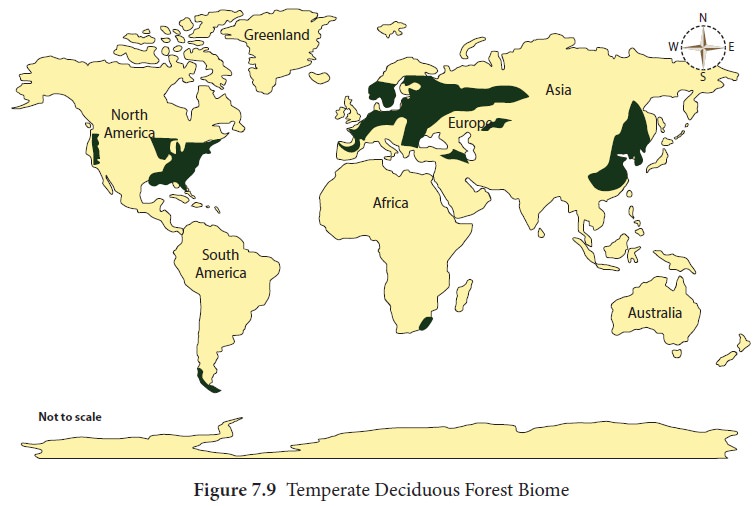
These biomes have four seasons such as winter, spring, summer and fall. Winters are cold and summers are warm. As winter approaches, the duration of day light decreases. In this biome, deciduous trees shed their leaves in the fall. The production of chlorophyll in the leaves slows and eventually stops revealing leaves having bright red, yellow and orange colors. These forests are also known as broad leaved forest, because the trees have wide flat leaves. Some important trees found here are oak, maple, beech, hickory, cedar and chestnut. On the forest floors that receive very little sunlight are found mosses, azaleas and mountain laurels.
Inhabiting the temperate deciduous forest are ants, insects, flies, bees, wasps, cicadas, walking sticks, moths, butterfly, dragon flies, mosquitoes and praying mantises.
Frogs, toads, snakes and salamanders are some of the reptiles in this biome. Common birds found in this biome are woodpecker, robin, jays, cardinals, owls, turkeys, hawks and eagles. Small mammals like rabbits, otters, monkeys, beavers, squirrels and porcupine are also seen in this biome along with bears, grey fox, wolves, white tailed deer and moose. Animals that live in this biome adapt to the changing seasons. Some animals migrate or hibernate in winter.
Most of this forests on the earth are cleared for agriculture. The soil here is very fertile. This is one of the most important agricultural regions of the world.
Grasslands
Grasslands are found bordering the deserts and make up for one fourth of the natural vegetation of the earth. Those that lie in the low latitudes are called tropical grasslands and the ones which lie in the mid latitudes are called temperate grasslands.
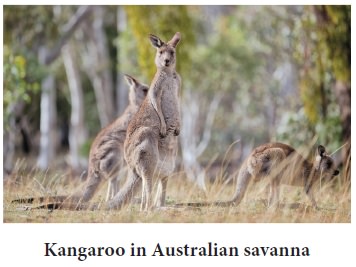
iv. Tropical Grassland Biome or Savanna Biome
The tropical grass land biome is generally referred to as the Savanna biome. A savanna is a rolling topography that features vast open grasslands scattered with small shrubs and isolated trees. It is found between the tropical rainforest and desert biome. Tropical grassland biomes are mainly found in Africa, South America and Australia. Tropical grasslands in Africa is known as the savannas. Tropical grasslands are called as llanos in Columbia and Venezuela and as Campos in Brazil of South America.
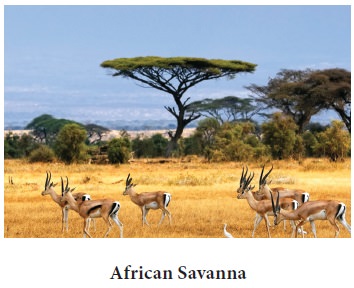
Savanna biomes experience warm temperature year around. It has very long and dry winter season and a very wet summer season. The grass here is very tall often one or two metres tall scattered with small shrubs and isolated umbrella shaped trees like the acacia and the baobab trees which store water in their trunks.
Most of the animals in the savanna have long legs, like the giraffe and kangaroo. The carnivorous animals like lions, leopards, cheetahs, jackal and hyenas live in this biome. Zebras and elephants are also found in this biome.
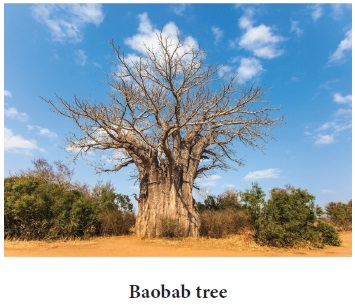
In many parts of the savannas of Africa people have started using the grassland for grazing their cattle and goats. Due to overgrazing in this region most of the tropical grasslands here are lost to the Sahara desert year after year.
v. Temperate Grassland Biome or Steppe
The temperate grassland biomes are generally found in the interior of the continents in the mid latitudes. These grassland biomes are found in the transitional zone between the humid coastal areas and the mid latitude deserts.
The temperate grasslands are known as Steppes in Europe and Asia, Prairies in North America (Canada and USA), Pampas in South America, Veldts in South Africa, Downs in Australia and Puszta in Hungary. The annual range of temperature is quite large with summer temperature reaching as high as 38°C and winter temperatures falling down to -40° C. The rainfall is moderate from 25 cm to 50 cm. Grasses form a The height of the grasses depends upon the amount and distribution of rainfall.major part of the vegetation in the temperate grasslands.
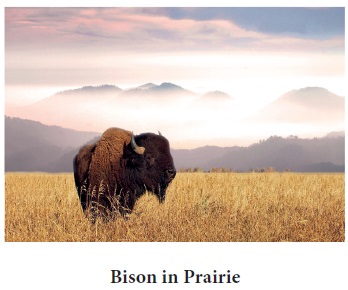
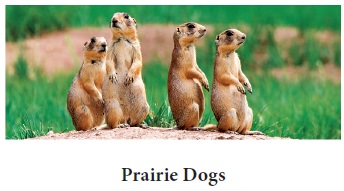
The height of the grasses depends upon the amount and distribution of rainfall.
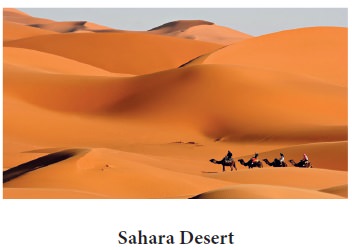
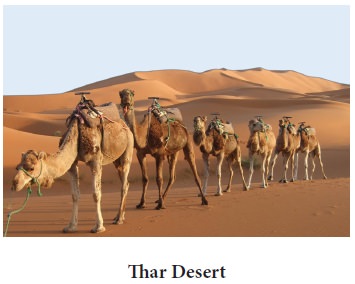
The animals in this area include the bison, wolves of the Prairies of North America. The other animals and birds are coyotes, prairie dog, foxes, mice, rabbits, badgers, rattle snakes, pocket gophers, weasel, grasshoppers, quails and hawks.
vi. Tropical Desert Biome
A tropical desert is the hottest and driest place on earth where rainfall is very scanty and irregular. This biome is typically found in the western parts of the continents within the tropics.
In the northern hemisphere, the Afro – Asian deserts form the longest belt which includes the Sahara desert, Arabian desert and the Thar deserts. In North America the tropical deserts cover, California, Arizona and New Mexico states of USA and it further extends to Mexico. The deserts in the southern hemisphere are, the Atacama desert west of Andes mountains in South America, the Namibian and the Kalahari deserts in southern Africa and the Great Australian desert in the central and southern parts of Australia.
The tropical deserts are not conducive for the growth of vegetation due to shortage of water. The plants found here are the xerophyteswhich have their own moisture conserving methods such as long roots, thick barks, waxy leaves, thorns and small leaves so as to avoid evapo-transpiration.
The main trees and bushes found in this region are acacia, cacti, date palm, kikar, babul etc.
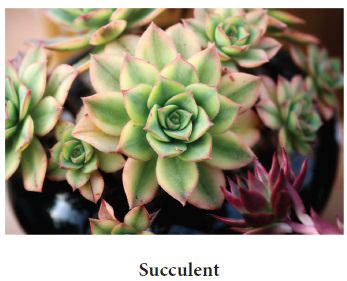
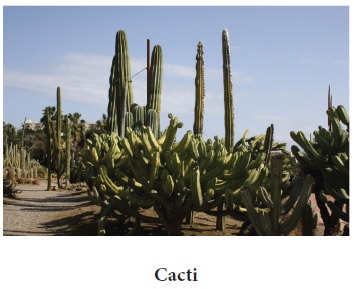
The animals in this biome are limited in number. They are able to bear the drought and the heat of the desert. Animals like the camel, antelopes, fox, spotted hyena, fallow deer, cape hare, hedgehog etc., live in the desert.
The tropical desert biomes are agriculturally unproductive except in and near the oasis. In the oasis, cultivation is carried through irrigation either from streams or from underground sources. Date palms are widely grown here.
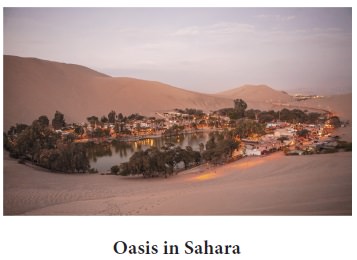
The people in the deserts are generally nomads living in tents and moving from place to place. They are the Berbers of North Africa, the Bedouins of the Arabian deserts, the Damara in Namibia, the Bushman of the Kalahari Desert and the Aborigines of Australia. They practice food gathering and hunting while some herd cattle, goats and camel and some of them practice very simple subsistence farming.
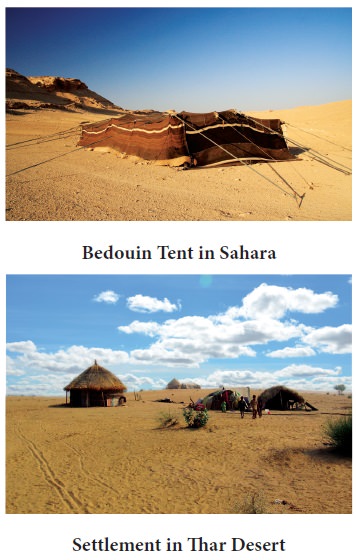
vii. Taiga or Boreal Forest Biome
The taiga biome is the largest terrestrial biome and extends across Europe, North America and Asia. The taiga biome is also known as coniferous forest or boreal forest biome. It extends from about 50° to 55° North to 65 ° to 70° North latitudes. This region lies between the temperate grassland in the south and the polar tundra in the north. The taiga region is absent in the southern hemisphere mainly because of the narrowing of continents towards the South Pole.
This biome has short wet summer and long cold winters. The taiga region has low mean annual precipitation ranging between 35 cm and 60 cm and the rainfall occurs mostly in summer. It receives plenty of snow during winter.
The taiga or boreal forest biome consists mainly of evergreen coniferous forests. The important coniferous trees in this biome are pines, spruces, firs, maples and cedars. During the short summer season snow melts and this helps lichens, mosses and short grasses to grow and cover the ground. These are called ‘meadows’.
Taiga is the home of some larger animals like moose, deer, and bears, while smaller animals like bobcats, squirrels, chipmunks, ermine, and moles are also found. Animals of the taiga have specialised adaptation including lot of thick fur or feathers and the ability to change colours during different seasons example ermine.
Fact File
The ermine is a small mammal, which is covered with thick dark brown fur in summer. This changes to white in the winter, an adaptation which helps the ermine to blend into its surroundings and makes it more difficult for the predators to spot them.
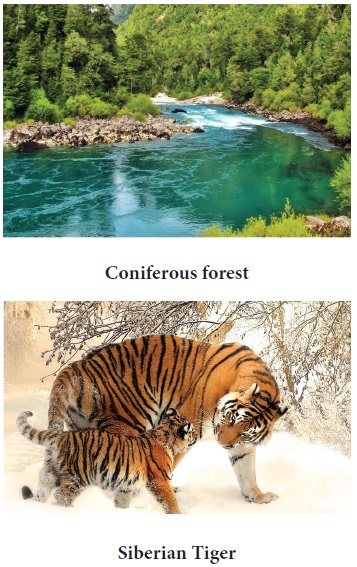
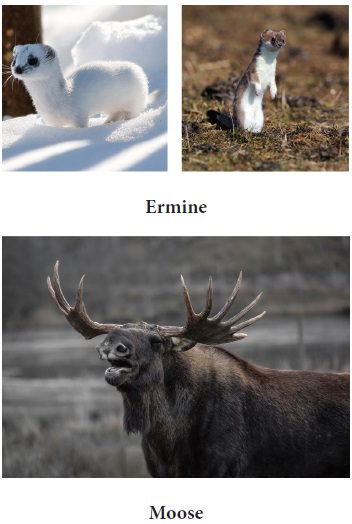
Lumbering is the main occupation of the people in areas which are easily accessible. The softwood from the coniferous forests is widely used in the manufacture of wood pulp and paper, newsprint, matches, furniture and building materials.
The hunting of fur bearing animals like musk rats, ermine, and silver fox are important economic activities. The taiga forest is endangered due to logging and mining by humans. When trees are cut down in the taiga it takes a very long time to restore itself because of the very short growing season.
viii. Tundra Biome
Tundra is a Finnish word which means barren land. The tundra region is a vast bowl lying beyond the Arctic Circle (66.5° North latitude) in the northern hemisphere along the shores of the Arctic Ocean. The Arctic tundra extends southwards from North Pole to the Taiga forest. Tundra is also found in the high altitudes especially in the Alpine region.
Due to long and severe cold winters, this region is treeless and has very little vegetation. The growing season for plants is very short. Natural vegetation mainly consists of shrubs, sedges, grasses, mosses and lichens.
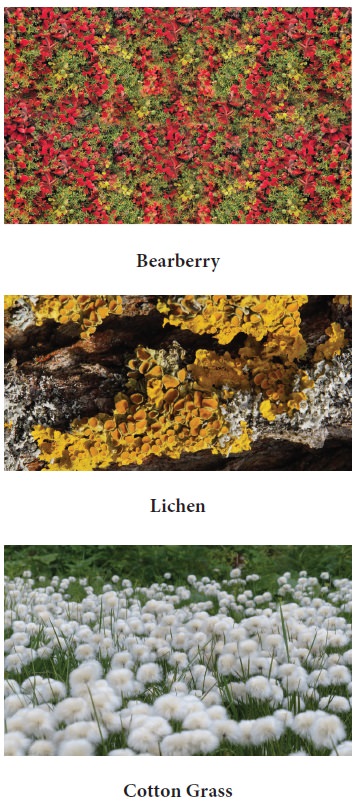

The main features of this climate in the tundra region are the general absence of insolation and presence of very low temperature throughout the year. The average annual temperature is about -12°C. The ground surface is covered with snow for at least 8 to 9 months in a year.
In this biome, the sub soil remains permanently frozen and is known as permafrost. Permafrost tundra covers vast barren areas of northern Russia and Canada. Algae and fungi are found on the rocky cliffs and rosette plants grow in rock and gravel beds. Spongy turf and lichen develop in the drier inland tundra.
Animals common to Arctic tundra are the polar bear, arctic wolf, arctic fox, arctic hare and arctic weasel. Large herbivores such as musk oxen, caribou and reindeer are found. Lemmings are also found in this Biome. Insects like moths, butterflies, beetles, mosquitoes and black flies are common in the Arctic tundra. Migratory birds include tundra swans, harlequin ducks, sand pipers, plovers, geese and gulls.
The Antarctic region is covered with ice sheets. It is too cold and dry to support vegetation. However, some portions of the continent have areas of rocky soil that support plant life. Vegetation comprises of mosses, lichens and liver worts. This area is referred to as Antarctic tundra. Seals and Penguins inhabit the shore areas of Antarctica.
Biodiversity
The term biological diversity was used as early as 1968 by wildlife conservationist Raymond F. Dasmann. Latter in 1988, entomologist E.O. Wilson used the term Biodiversity and this term has been used since then. Biodiversity refers to the variety of life on Earth. This includes the number of species of plants, animals and microorganisms along with the diversity of genes in these species. Moreover, it embodies the different ecosystems on the planet, for example forests, deserts, coral reefs and wetlands.
Biodiversity is the variability among living organisms. This includes diversity within species, between species, and between ecosystems. The variety of biodiversity or the number of species in a given area is referred to as species richness. Normally variety of life increases with size of area.
Biodiversity can be identified at three levels:
- Genetic diversity
- Species diversity and
- Ecosystem diversity
a. Genetic diversity refers to the total number of genetic characteristics in the genetic makeup of a species. Example: Each human being is very different from others. Genetic diversity helps the population to adapt to changes in the environment or adapt to different environments. Domestication of dogs can be taken as a common example.
b. Species diversity is the number of different species of plants and animals that are present in a region. A community with more number of species enjoys species richness. Naturally undisturbed forests have greater species richness than reforested areas or plantations.There are three types of Species:
- Endemic species – is one whose habitat is restricted only to a particular area because of which it is often endangered. It differs from “indigenous,” or “native,” which although it occurs naturally in an area, is also found in other areas.
- Exotic Species – is any species intentionally or accidentally transported and released by man into an environment outside its original range. These are often the most severe agents of habitat alteration and degradation, and a major cause of the continuing loss of biological diversity throughout the world.
- Cosmopolitan Species – It is a species that is found to be distributed over most regions of the earth example: cats, dogs, human beings. The killer whale is considered as the most cosmopolitan species in the world.
c. Ecosystem diversity refers to the variety of life forms in a prescribed ecosystem. Ecosystems may be both terrestrial and aquatic. Distinctive terrestrial ecosystems include forests, grasslands, deserts, etc. while aquatic ecosystems are rivers, lakes, oceans etc.
In understanding biodiversity, the most common question that arises in our mind is how many different plant and animal species are there on earth? There can be no definite answer to this question. At present the conservation scientists have identified over 8.7 million species worldwide. Of this only about 2 million are known to us ranging from microorganisms to giant mammals and reptiles. New species are being discovered while many species are also disappearing from the face of the earth.
Biodiversity hotspots
Areas that are rich in species diversity are called as “Hotspots”. The hottest spots for species diversity are the tropical rainforests. Tropical rainforests comprise of only 7% of all land on earth, yet are home to nearly 50% of all the species on Earth! India is among the World’s 17 nations that are exceptionally rich in species diversity.
The British biologist Norman Myers coined the term ‘biodiversity hotspot’ in 1988. According to him, a biodiversity hotspot is a biogeographic region characterised both by exceptional levels of plant endemism and by serious levels of habitat loss. Conservation International (CI) adopted Myers concept of ‘hotspots’ and it made an extensive global study of hotspots in 1999. According to CI, to qualify as a hotspot a region must meet two strict criteria: (i) It must contain at least 1,500 species of endemic plants, and (ii) It must have lost at least 70% of its original habitat. In 1999, CI’s book ‘Hotspots: Earth’s Biologically Richest and Most Endangered Terrestrial Ecoregions’, identified 34 biodiversity hotspots in the different countries of the world.
Currently there are 34 biodiversity hotspots that have been identified and, most of them occur in tropical forests (Figure 7.10). They represent just 2.3% of Earth’s land surface, but between them they contain around 50% of the world’s endemic plant species and 42% of all terrestrial vertebrates.
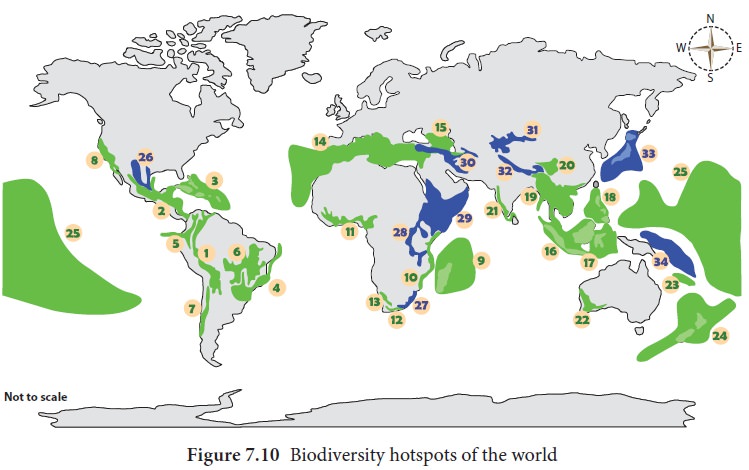
India has 4 biodiversity hotspots: the Western Ghats, the Himalayas, the Indo-Burma region and the Sundaland [includes Nicobar group of Islands].
Fact File
Endemism is an ecological word meaning that a plant or animal lives only in a particular geographical location, such as a specific island, habitat type, country or any defined zone. For example, The Asiatic Lion of the Gir forest of Gujarat. The Kashmir Stag known as Hangul, which is found in the riverine forests of Kashmir Valley and Chamba in Himachal Pradesh. The Lion Tailed Macaque is India’s most threatened monkey which is endemic to the Western Ghats of South India.
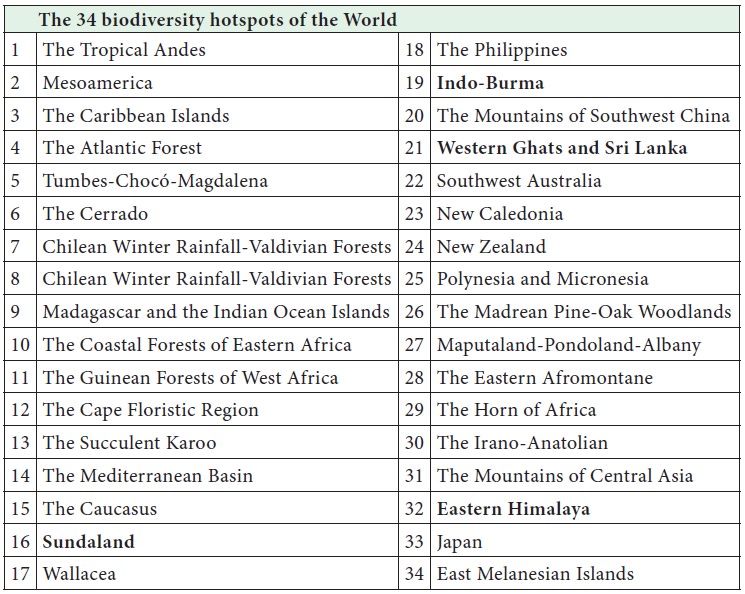
Endangered species
Rare, endangered or threatened plants and animals are elements of our natural heritage that are declining rapidly. If we cherish these species, like we do other rare and beautiful objects, these living organisms become treasures of the highest magnitude.
The International Union for the Conservation of Nature (IUCN) has identified and classified species based on the nature of their depleting numbers. The IUCN’s Red List of Threatened Species, identified in 1964, is the world’s most important inventory of the global conservation status of biological species.
Species are classified by the IUCN Red List into nine groups specified through criteria such as rate of decline, population size, area of geographic distribution, and degree of population and distribution fragmentation (Figure 7.11).

- Extinct (EX) – The species has disappeared and no known individuals remaining
- Extinct in the wild (EW) – Known only to survive in captivity, or as a naturalized population outside its historic range
- Critically Endangered (CR) – Species that have drastically dwindled and are at extremely high risk of extinction in the wild
- Endangered (EN) – High risk of extinction in the wild
- Vulnerable (VU) – High risk of endangerment in the wild
- Near threatened (nt) – Likely to become endangered in the near future.
- Least concern (lc) – Lowest risk widespread and abundant
- Conservation dependent (cd) – This group has now merged with near threatened.
- Data deficient (dd) – Not enough data to assess the risk of extinction of the species.
- Not evaluated (ne) – Species not yet been evaluated against the criteria.
In the context of the IUCN Red List, ‘threatened’ embraces the three categories of Critically Endangered, Endangered, and Vulnerable.
According to the IUCN those species that have dwindled drastically are called as Critically Endangered and are included as Red List. Species that have disappeared are called as extinct species. In the Red List of 2012 that was released on 19 July 2012 at Rio+20 Earth Summit 19,817 species were threatened with extinction.
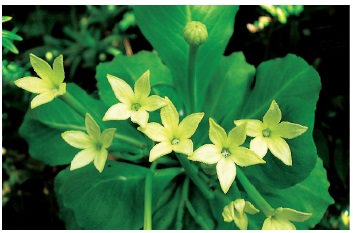
A Hawaiian plant species called Alula locally referred to as cabbage on a stick has moved from Critically Endangered to Extinct in the Wild. It is one of the 38 Red Listed Hawaiian plant species with less than five wild individuals remaining. It used to grow on the windy sea cliffs of Kauai. Alula was destroyed by hurricanes Iwa and Inki in 1982 and 1992 leaving only less than 10 plants alive.
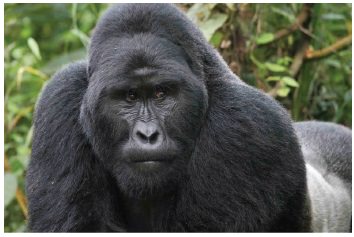
The majority of the great ape species are now Critically Endangered. The Eastern Gorilla the largest living primate is endemic to the Eastern Democratic Republic of Congo, south western Uganda and Rwanda. This species which was listed as Endangered has moved to Critically Endangered in 2016 due to an ongoing population decline. This decline is due to illegal hunting and destruction of forests for agriculture. If this trend continues, around 93% of Eastern Gorillas will be eliminated by 2054.
The Pygmy Hog: It is the smallest and rarest wild pig on earth and it is a Critically Endangered species previously spread across Bangladesh, Bhutan, India and Nepal. but now only found in Assam, India. In 1995, the Pygmy Hog Conservation Programme was started by Goutam Narayan of Ecosystems-India, with the help of the Assam government and now their numbers have increased to about 150.
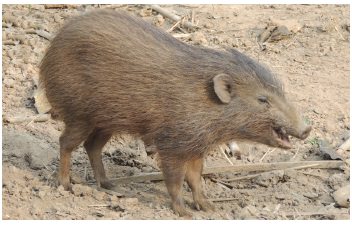
There are many other critically endangered species in India and some of them are listed below
Critically Endangered species in India 2016
Arthropoda
- Rameshwaram parachute spider
- Peacock tarantula
Birds
- White-bellied heron
- Great Indian bustard
- Forest owlet
- Spoon-billed sandpiper
- Siberian crane
- Indian vulture
- Himalayan quail
- Pink-headed duck
Fish
- Wayanad mahseer
- Pondicherry shark
- Ganges shark
- Pookode Lake barb
- Common sawfish
Insects
- Pygmy Hog Sucking Louse
Reptiles and amphibians
- Madras spotted skink
- Gharial
- Toad-skinned frog
- Charles Darwin’s frog
- White-spotted bush frog
- Munnar bush frog
- Ponmudi bush frog
- Anaimalai flying frog
Mammals
- Asiatic cheetah
- Namdapha flying squirrel
- Himalayan wolf
- Andaman shrew
- Nicobar shrew
- Northern Sumatran rhinoceros
- Chinese pangolin
- Pygmy hog
- Indian Javan rhinoceros
- Malabar large-spotted civet
The Recent Red List (2017)
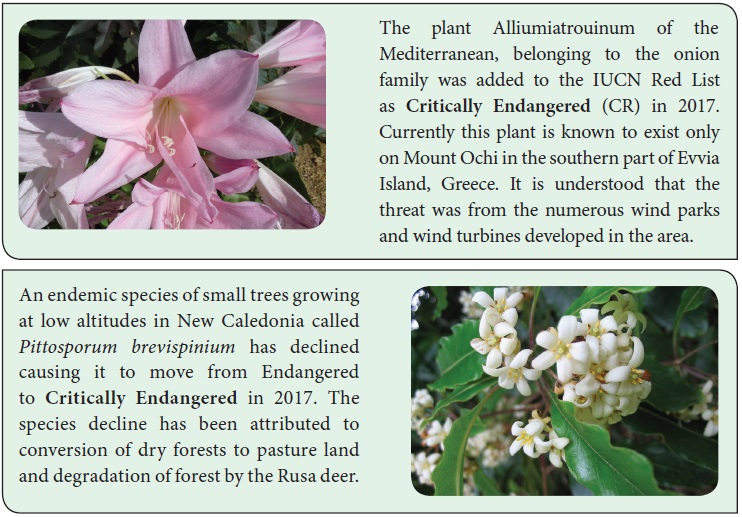
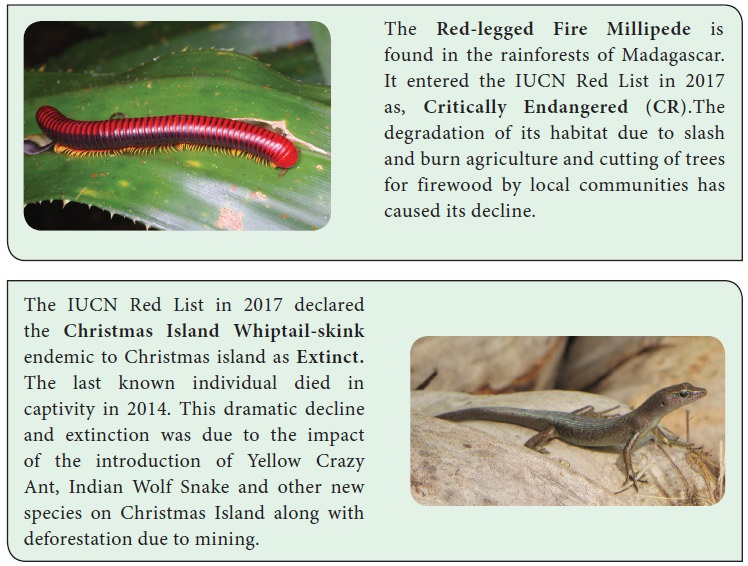
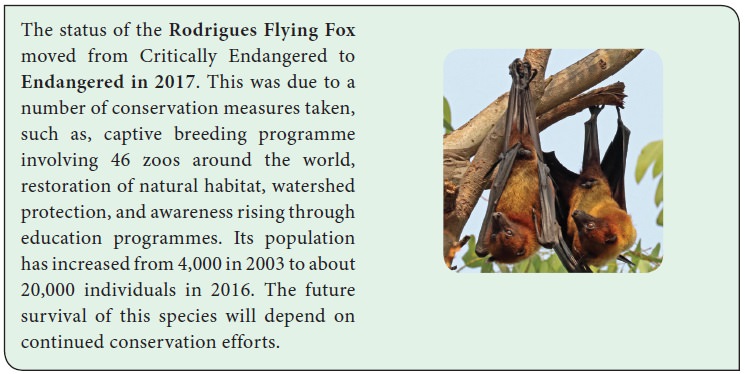
The plant Alliumiatrouinum of the Mediterranean, belonging to the onion family was added to the IUCN Red List as Critically Endangered (CR) in 2017. Currently this plant is known to exist only on Mount Ochi in the southern part of Evvia Island, Greece. It is understood that the threat was from the numerous wind parks and wind turbines developed in the area.
An endemic species of small trees growing at low altitudes in New Caledonia called Pittosporum brevispinium has declined causing it to move from Endangered to Critically Endangered in 2017. The species decline has been attributed to conversion of dry forests to pasture land and degradation of forest by the Rusa deer.
The Red-legged Fire Millipede is found in the rainforests of Madagascar. It entered the IUCN Red List in 2017 as, Critically Endangered (CR).The degradation of its habitat due to slash and burn agriculture and cutting of trees for firewood by local communities has caused its decline.
The IUCN Red List in 2017 declared the Christmas Island Whiptail-skink endemic to Christmas island as Extinct. The last known individual died in captivity in 2014. This dramatic decline and extinction was due to the impact of the introduction of Yellow Crazy Ant, Indian Wolf Snake and other new species on Christmas Island along with deforestation due to mining.
The status of the Rodrigues Flying Fox moved from Critically Endangered to Endangered in 2017. This was due to a number of conservation measures taken, such as, captive breeding programme involving 46 zoos around the world, restoration of natural habitat, watershed protection, and awareness rising through education programmes. Its population has increased from 4,000 in 2003 to about 20,000 individuals in 2016. The future survival of this species will depend on continued conservation efforts.
Causes of Extinction of Species
Extinction is defined as the permanent disappearance of an organism from the face of the earth. In other words, all members of a species have died. This means a loss of biodiversity. Extinction of species may take place (Figure 7.12) due to a variety of causes as given below:
- Sudden and rapid changes of environmental conditions
- The sudden outbreak of disease and pest infections.
- Some sudden events like forest fires, volcanic eruption etc.
- Direct hunting and persecution of species leading to ‘selective mass extinction.
- Ecological substitution by other species of large carnivorous animals which compete for the same food resources.
- Climatic change accelerates the competition between large mammals for shelter and food.
- Extinction of weak species during the course of competition with more powerful and stronger species.
- Man-induced environmental changes also cause species extinctions.
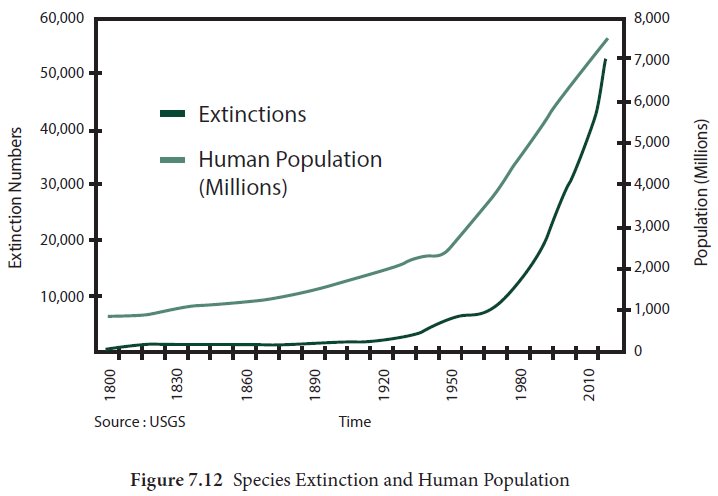
Between 1600 and 1900 it is estimated that one species went extinct every four years. In modern times, the rate is soaring. The graph below (Figure 7.12.) shows how the rate of extinction of species has increased over the past 50 years. This could be attributed to the rapid increase in population during the same period of time.
According to IUCN the rate of extinction of mammals and birds had started much earlier by 1700 itself at a much faster rate as shown in the graph below (Figure 7.13).
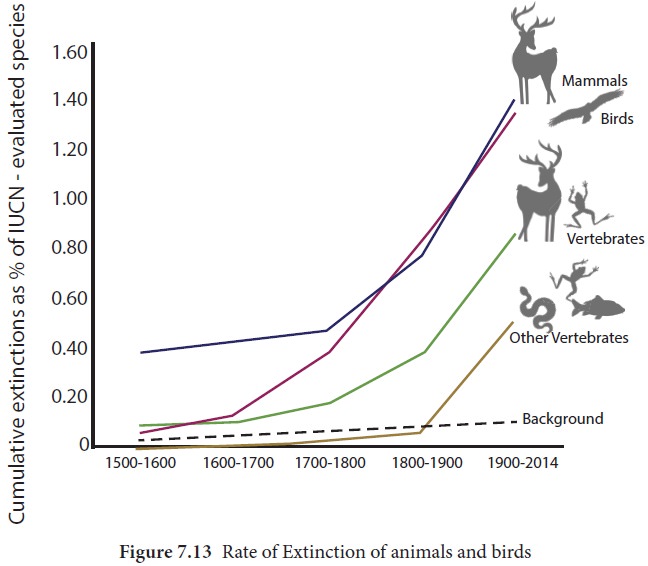
Major Threats to Biodiversity
The following are some of the major threats to biodiversity:
- Habitat destruction and degradation
- Invasive alien species-these can destroy native species Example, lantana Camera plant in India.
- Climate Change- Example, bleaching and loss of coral reefs due to global warming
- Pollution of air, water and soil – Pollution can alter the growth and life of organisms in a great way.
- Over exploitation of one resource – Over exploitation through Hunting or Poaching, Deforestation etc., can influence the life of all the interdependent species.
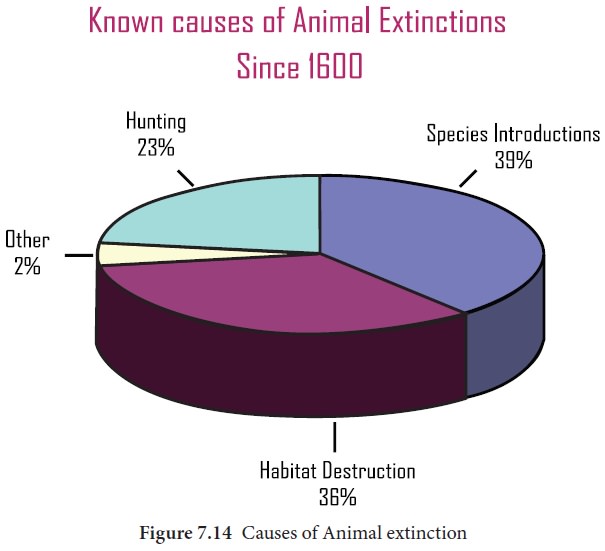
Despite rapid efforts in protecting terrestrial and marine habitats, world’s diversity of species is still dwindling. Since the 1960’s over 100,000 ‘protected areas’ have been established. This represents 11,265,408 sq.km of land and 1,609,344 sq.km of ocean. Yet, terrestrial and marine species have declined over the same period. This suggests that the common conservation strategy of protecting areas of land and sea is inadequate.
Conservation of Biodiversity
Conservation of bio-diversity is the proper management of the biosphere by human beings in such a way that it gives maximum benefits for the present generation and also develops its potential to meet the needs of the future generations.
The three basic objectives of biodiversity conservation are:
- To maintain essential ecological processes and life supporting systems.
- To preserve the diversity of species.
- To make sustainable utilization of species and ecosystems.
There are two types of conservation methods (Figure 7.15) namely in-situ and ex-situ conservations.
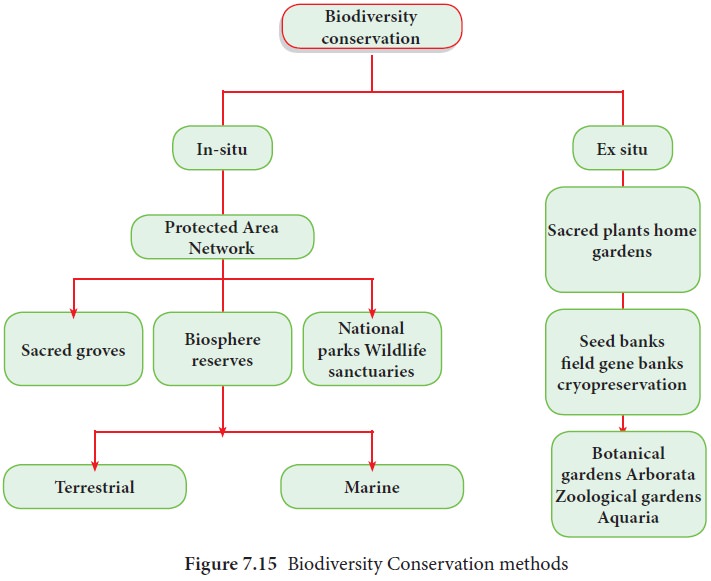
In-situ conservation means the conservation of species within their natural habitats. This strategy involves identification of species rich areas and adopting methods to protect it in the form of National Park or Wildlife Sanctuary or Biosphere Reserve etc. In this way biodiversity can be conserved in their natural habitat from human activities.
Ex-situ conservation involves maintenance and breeding of endangered plants and animals under partially or wholly controlled conditions in specific areas like zoo, gardens, nurseries etc.
Other examples of ex-situ conservation include:
- Seed gene bank
- Field gene bank
- Botanical gardens
Biodiversity conservation in India
India is one of the 17 mega bio-diverse countries of the world (according to Conservation International). With only 2.4% of the world’s land area, 16.7% of the world’s human population and 18% of livestock, it contributes about 8% of the known global biodiversity. India has a number of globally important endangered species like Asiatic lion, Asian elephant, one-horned rhinoceros, Gangetic river dolphin, snow leopard, Kashmir stag, dugong, gharial, great Indian bustard, lion tailed macaque etc. The following steps have thus been taken to protect and manage the wildlife of the country.
- The Government of India enacted the Wild Life (Protection) Act 1972 with the objective of effectively protecting the wild life of this country and to control poaching, smuggling and illegal trade in wildlife and its derivatives.
- The National Board for Wildlife (NBWL) chaired by the Prime Minister of India, provides for policy framework for wildlife conservation in the country.
- The National Wildlife Action Plan (2002–2016) was adopted in 2002, emphasizing the people’s participation and their support for wildlife conservation.
- The Indian Constitution lays the subject of forests and wildlife in the Concurrent list thus laying the responsibility of wildlife conservation on both the Centre and the State.
- Specialised projects: To save the endangered species of animals, specialised projects are being implemented with international cooperation (WWF, UNDP, UNEP, IUCN) as well as on a stand-alone basis like the following: (Table 7.1)
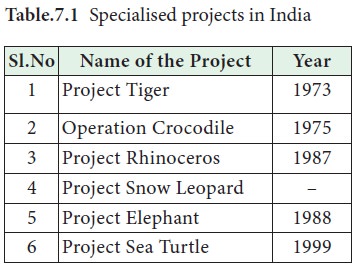
More recently, the Black Buck (chinkara) the Great Indian Bustard and the snow leopard have been given full or partial legal protection against hunting and trade throughout India.
6. The Protected Areas of India
Protected areas are those in which human occupation is small and exploitation of resources is limited. These are defined according to the categorization (Table 7.2.).

There are 4 categories of the Protected Areas in India.
- National Parks,
- Wildlife Sanctuaries,
- Conservation Reserves
- Community Reserves.
National Park
- National parks in India are IUCN category II protected areas.
- A National park is an area with ecological, geomorphological and natural significance with rich fauna and flora, designed to protect and to develop wildlife or its environment.
- Activities like grazing, hunting, forestry or cultivation etc. are strictly prohibited.
- No human activity is permitted inside the national park.
- India’s first national park was established in 1936 as Hailey National Park, now known as Jim Corbett National Park, Uttarakhand.
- There are 103 national parks in India (National Wildlife Database, April 2015).
Wildlife Sanctuary
- The difference between a Sanctuary and a national park lies mainly in the rights of people living inside. In a Sanctuary, certain rights are allowed but in a national park, no rights are allowed for grazing of any livestock. In a wildlife Sanctuary, the Chief Wildlife Warden may regulate, control or prohibit certain activities.
- There are a total of 537 wildlife sanctuaries in India.
Conservation reserves and community reserves in India:
- These terms denote the protected areas of India which typically act as buffer zones between established national parks, wildlife sanctuaries and reserved and protected forests of India.
- They are called as ‘Conservation Reserves’ if they are uninhabited and completely owned by the Government of India but used for subsistence by communities.
They are called ‘Community Reserves’ if a part of the land is privately owned.
Biosphere Reserves
A biosphere reserve is an area of land or water that is protected by law in order to support, sustain and conserve ecosystems.
Biosphere Reserves of India protect very large areas of natural habitat that are much bigger than national parks or wildlife sanctuaries. Biosphere reserves may cover multiple national parks, sanctuaries and reserves which are contiguous.example, the Nilgiri Biosphere covers: Bandipur National Park, Mudumalai Tiger Reserve, Silent Valley National Park, Nagarhole National Park and Mukurthi National Park.(Figure 7.16)
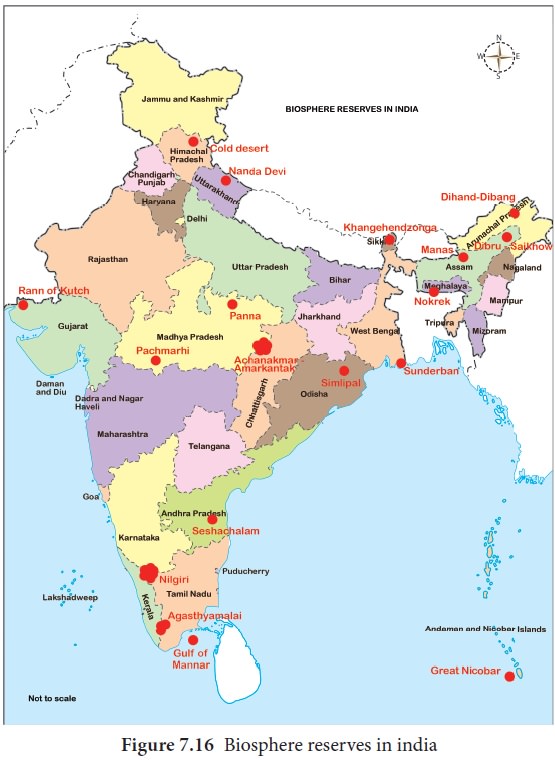
Biosphere reserves are traditionally organized into 3 interrelated zones, known as: Core area, Buffer zone, and Transition zone.
Presently, there are 18 notified biosphere reserves in India. Ten out of the eighteen biosphere reserves are a part of the World Network of Biosphere Reserves, based on UNESCO’s Man and the Biosphere (MAB) Programmed list. buffer zones between established national parks, wildlife sanctuaries and reserved and protected forests of India.
8. Some Other Important Conservation Sites
Tiger Reserves – Project Tiger was launched by the Government of India in the year 1973 to save the endangered species of tiger in the country. Starting from nine (9) reserves in 1973 the number has now grown to fifty (50) in 2016. Table 7.2. gives a list of conservation sites and their numbers in India.
9. Role of communities
Communities are playing a vital role in the conservation and protection of wildlife in India, example:
- Sariska Tiger Reserve: In Sariska tiger reserve Rajasthan villagers have fought against mining by citing the wildlife protection act. In many areas, villagers themselves are protecting habitats and explicitly rejecting government involvement.
- Bhairodev Dakav Sonchuri: The inhabitants of five villages in the Alwar district of Rajasthan have declared 1200 hectares of forests as the Bhairodev Dakav Sonchuri declaring their own set of rules and regulation which do not allow hunting, and are protecting the wildlife against any outside encroachments.
- Bishnoi villages: In and around Bishnoi villages in Rajasthan, herds of blackbuck, nilgai and peacocks can be seen as an integral part of the community and nobody harms them.
The Role of GIS in Conservation of Nature
Recently Geographic Information System (GIS) has been used as a tool to identify new areas that need to be conserved. In the last 15 years Remote Sensing and GIS has been used to developed gap analysis as a method to identify biodiversity (i.e., species, ecosystems and ecological processes) that is not adequately conserved within a protected area network or through other effective and long-term conservation measures. Gap analysis is a method of comparison of actual performance with potential or desired performance. It was thus developed in response to recognition, that protected areas of all types and in all parts of the world do not fully protect biodiversity. Gap analysis is usually applied to fairly large areas of study.
Highlight:
In 1798, in a small village called Vedanthangal near Chennai, the British soldiers shot some storks in the local wetland. The villagers stormed the Collector’s office and made him issue an order not to harm the nesting birds. This took place long before the concept of conservation of biosphere entered our thoughts. India has experienced many such incidents only some of which have been recorded.
Biodiversity is necessary for our existence as well as valuable in its own right. This is because it provides the fundamental building blocks for the goods and services that provide us with a healthy environment.Biodiversity includes fundamental things to our health like fresh water clean air and food products, as well as many other products like timber, medicine and fibre.
Biodiversity also includes various other important things and services such as cultural, recreational and spiritual nourishment that play an important role in maintaining our personal life and social life.
It is therefore the duty of every citizen to conserve this valuable life on earth, the most precious gift we can pass on to the future generations.
